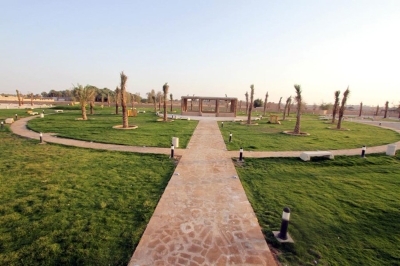
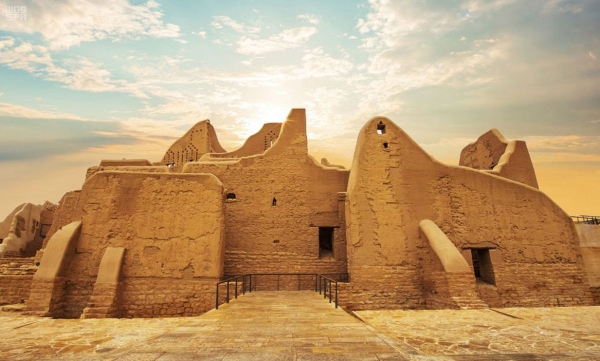
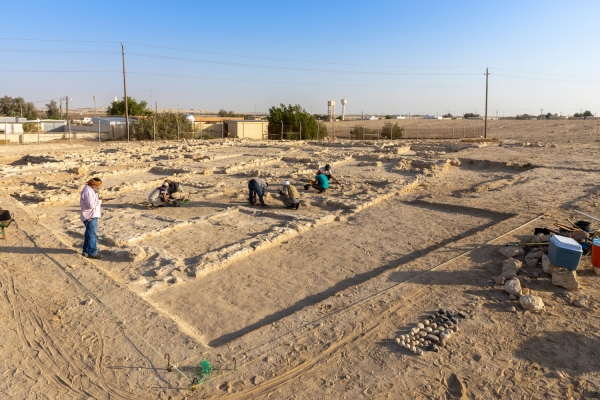
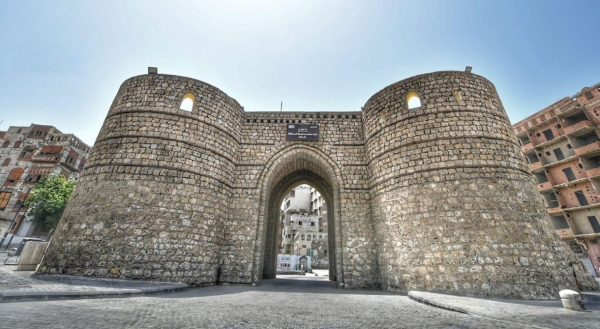
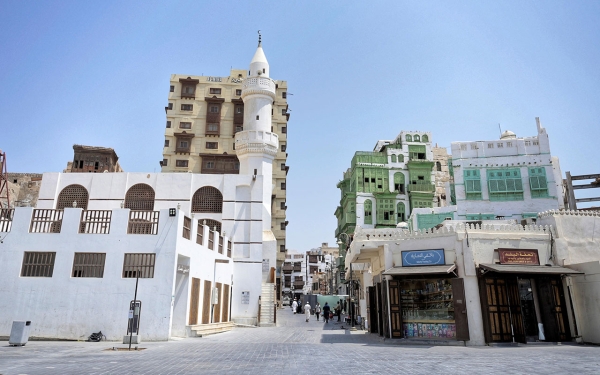
Antiquities in the Kingdom of Saudi Arabia are immovable, movable, buried, or submerged objects that are at least one hundred years old and located within Saudi Arabia's land borders and in maritime areas under its sovereignty.
Classification of antiquities in Saudi Arabia
Antiquities in Saudi Arabia vary between those constructed, crafted, produced, modified, or drawn by humans, acquiring archaeological characteristics through human intervention over the ages. These include historical sites, sites of folk heritage, and their artifacts.
Immovable antiquities
Immovable antiquities are those connected to the land, including natural or excavated caves used by humans, rocks on which images or inscriptions were drawn or carved, cairns, stone circles, urban and rural ruins, visible or buried structures, water facilities, ancient trade and pilgrimage routes, traditional cities, villages, and neighborhoods, buildings constructed for various purposes, their ruins, and associated architectural elements.
Movable antiquities
Movable antiquities are artifacts originally crafted to be naturally detached from the ground or from immovable antiquities, and which can be relocated. These include sculptures, coins, inscriptions, jewelry, adornments, and heritage pieces that hold national value due to their historical, scientific, aesthetic, artistic, traditional nature, or prolonged use.
Urban heritage
Everything built by humans, including cities, villages, neighborhoods, and buildings, along with the spaces, structures, and items they contain, which hold architectural, historical, scientific, cultural, or national value.
Historical sites
Locations that witnessed significant historical or national events or were mentioned in literary heritage, and do not necessarily contain visible or buried antiquities.
Folk heritage sites
Places where social, cultural, craft-related, or economic activities connected to folk heritage are held or organized.
Folk heritage artifacts
Tools and objects made or used by humans in later eras in any province of Saudi Arabia to manage their daily lives, including food, clothing, housing, education, self-defense, health preservation, and recreational tools.
Museums
Places where archaeological, artistic, cultural, historical, or scientific items are permanently exhibited, serving cultural, educational, or recreational purposes, and open to the public at fixed times.
Ownership of antiquities in Saudi Arabia
All immovable and movable antiquities located within Saudi Arabia or in maritime areas under its sovereignty or legal jurisdiction are considered public property of the state. Exceptions include immovable antiquities whose ownership is proven by their owners before the relevant authorities, movable antiquities registered by their owners, and movable antiquities deemed by the relevant authority as not requiring registration.
Preservation of antiquities in Saudi Arabia
The Heritage Commission, affiliated with the Ministry of Culture, works to discover, preserve, and document archaeological sites in Saudi Arabia within the National Antiquities Register. These sites are also marked on the official maps of Saudi Arabia.
According to global standards for registering antiquities, some archaeological sites in Saudi Arabia are classified as natural sites, such as al-Ahsa Oasis, others as historical and cultural, and some as mixed. Organizationally, some sites are open to visitors, while others remain protected.
Antiquities in Saudi Arabia registered with UNESCO
These are sites of exceptional cultural and historical value, elevated to be part of the shared heritage of humanity as described by the United Nations Educational, Scientific and Cultural Organization (UNESCO) World Heritage Convention, which Saudi Arabia ratified in 1978. The number of heritage sites in Saudi Arabia registered with UNESCO up to 2024 is eight, as follows:
Hegra
In 2008, the first Saudi site was officially registered on the World Heritage List: Hegra, located in alUla Governorate, northwest of Saudi Arabia. It contains enduring evidence of the Nabataean civilization between the second and third centuries BCE, including 153 rock-carved facades, as well as remnants from pre-Nabataean periods, such as tombs, cave drawings, inscriptions, and wells.
Turaif District
Two years after Hegra entered the World Heritage List, the historic Turaif District, located in Diriyah Governorate, northwest of Riyadh City, followed in 2010, becoming the second Saudi site to be registered on the World Heritage List. This historic district, established in the eighteenth century, includes administrative buildings from which the affairs of the First Saudi State were managed, the residence of its founder Imam Mohammed Bin Saud and his family, as well as prominent landmarks, palaces, and archaeological buildings in Diriyah, such as Salwa Palace and the Imam Mohammed Bin Saud Mosque.
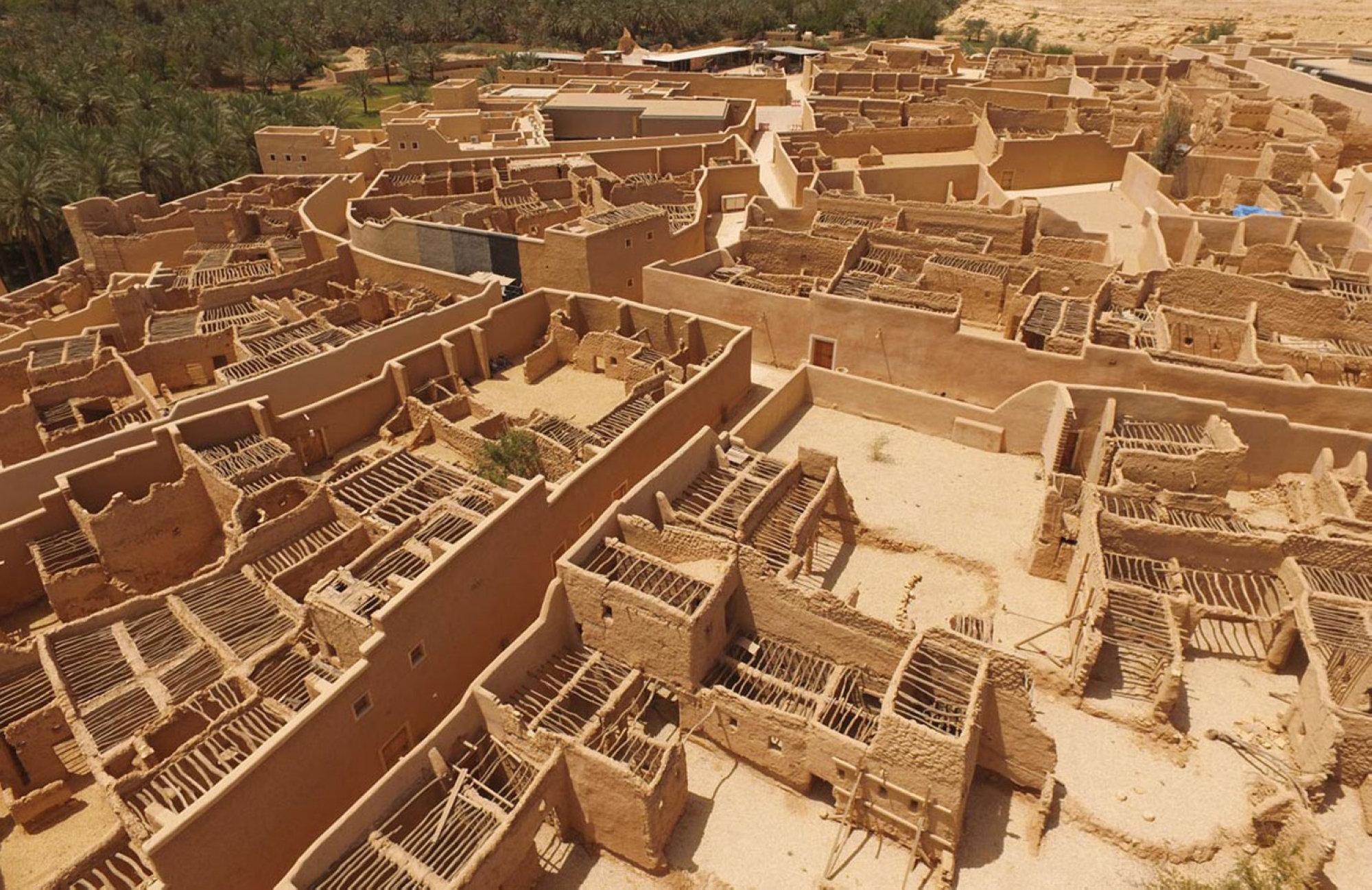
Historic Jeddah
In 2014, the World Heritage Committee approved the registration of Historic Jeddah, making it the third site in Saudi Arabia to join the World Heritage List. This area was designated by Caliph Uthman Bin Affan, may Allah be pleased with him, as the main port for receiving pilgrims heading to the holy sites in Makkah al-Mukarramah in 647. It includes a number of historical buildings, mosques, and ancient military sites.
Rock art in Hail Province
A year after Historic Jeddah joined the World Heritage List, the Rock Art in Hail Province was added in 2015. This site contains thousands of Thamudic inscriptions and rock drawings, the oldest of which date back to the Neolithic period, and is classified as one of the world's most distinguished rock art sites.
Al-Ahsa Oasis
In 2018, the World Heritage Committee inscribed al-Ahsa Oasis as the fifth Saudi site on the World Heritage List. This agricultural and archaeological area in the eastern part of Saudi Arabia spans over eighty-five km, making it the largest oasis in the world, as recorded by the Guinness World Records. It contains approximately 2.5 million date-producing palm trees and includes several historical buildings, such as the Qaisariya Heritage Market, the (House of Culture), Jawatha Historical Mosque, Ibrahim Palace, and Bayt al-Bay'ah (al-Mulla), in addition to its gardens.
Hima Cultural Area
It is an archaeological site in Najran, located southwest of Saudi Arabia, inscribed on the United Nations Educational, Scientific and Cultural Organization (UNESCO) World Heritage List in 2021. It is considered one of the largest open-air museums for archaeological rock inscriptions, containing archaeological sites, inscriptions, and rock drawings. The rock art in Hima Cultural Area spans an area of 557 km.
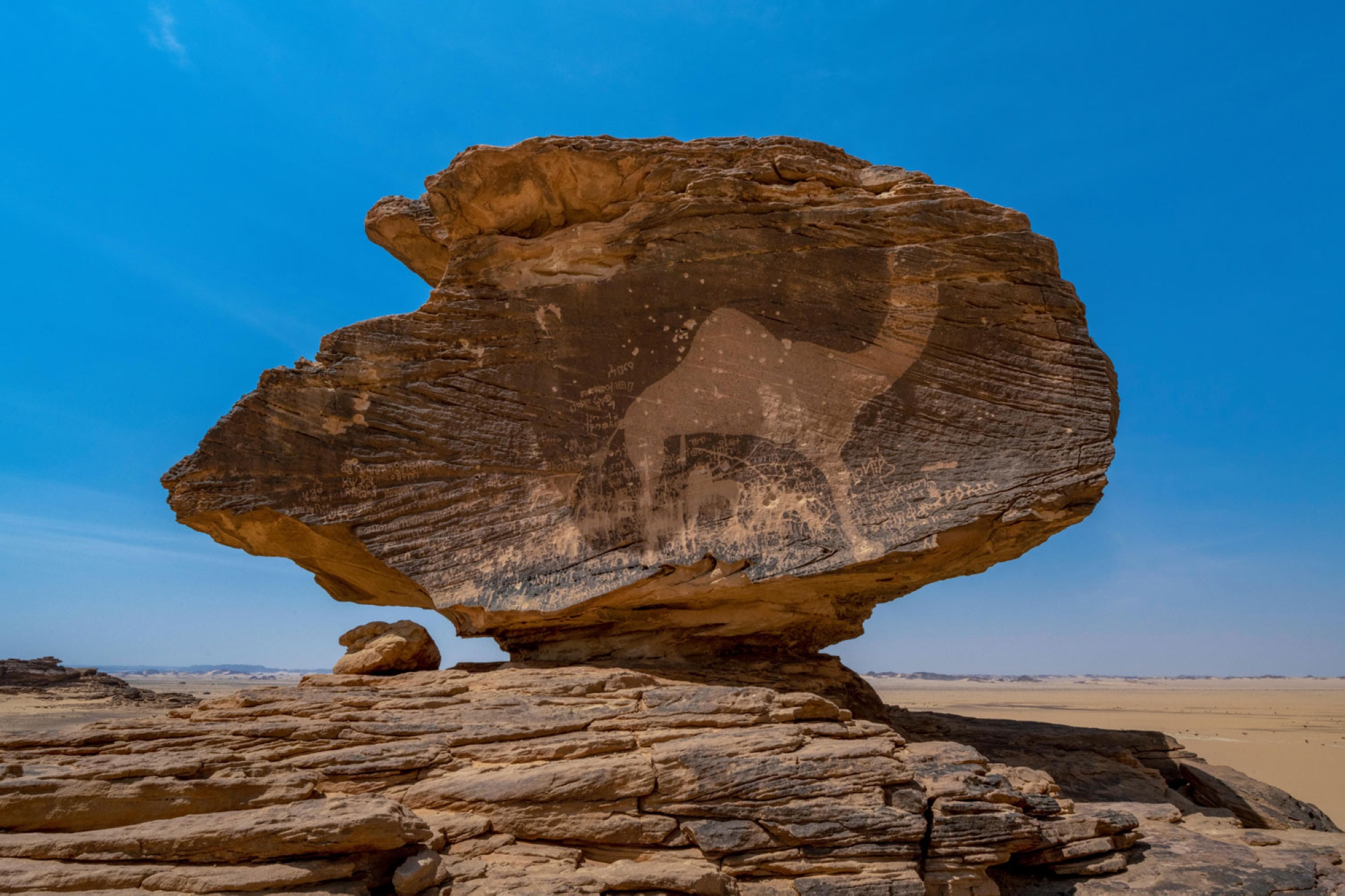
Uruq Bani Mu'arid Reserve
On September 20, 2023, Uruq Bani Mu'arid Reserve was announced as a World Heritage Site, becoming the first natural World Heritage Site within Saudi Arabia's territory. The reserve is located along the western edge of al-Rub' al-Khali (Empty Quarter), covering an area exceeding 12,787 km². It includes approximately 120 species of native wild plants and endangered wildlife, including the world's only free-ranging herd of Arabian oryx, as well as mountain gazelles (Gazella gazella) and the Arabian sand gazelle (Gazella marica).
Al-Faw Archaeological Area
In 2024, the Cultural Landscape of al-Faw Archaeological Area, located south of Riyadh Province, was announced as a UNESCO World Heritage Site for its exceptional cultural value to human heritage. This marks the eighth Saudi site to be listed as a World Heritage Site by UNESCO. Al-Faw Archaeological Area is situated in Wadi ad-Dawasir Governorate, south of Riyadh Province. It spans a protected area of fifty km², surrounded by a buffer zone of 275 km², at the intersection of al-Rub' al-Khali (Empty Quarter) and the terrain of the Tuwaiq Mountains, forming a narrow passage known as "al-Faw."
Inclusion of Saudi heritage sites in the World Heritage List
The inclusion of Saudi heritage sites in the World Heritage List signifies that these sites meet at least one of the ten criteria established by the committee. These criteria include: representing a masterpiece of human creative genius; reflecting significant shared human values over a period of time; bearing exceptional testimony to a living or vanished civilization; serving as an outstanding example of architectural or urban types illustrating a significant stage in human history; exemplifying traditional human practices in land or sea use that represent a culture or interaction with the environment; being directly associated with events, living traditions, ideas, beliefs, or works of universal artistic or literary significance; containing superlative natural phenomena or areas of exceptional natural beauty; offering outstanding examples of Earth's major evolutionary stages, including records of life and significant geological processes in landform development; showcasing unique examples of significant ecological and biological processes in the evolution of terrestrial ecosystems; and housing the most significant natural habitats for biodiversity conservation, including species threatened with extinction.
Archaeological sites in Saudi Arabia
Antiquities in Riyadh Province
Riyadh Province is home to numerous antiquities and cultural landmarks that reflect its history, including:
The Heritage Village in al-Ghat: Located in al-Ghat Governorate, north of the capital, Riyadh, it features the Emirate Palace built in Islamic architectural style, al-Oshaza Mosque, which exemplifies traditional Najdi mosque architecture, the historic Mughiran Fortress, the two remaining watchtowers from the village wall, and a collection of mud-brick houses showcasing traditional architecture.
Ushayqir Heritage Village: An archaeological village located in Shaqra Governorate, dating back to the pre-Islamic era. It includes several archaeological sites, such as ancient wells, al-Wuhaibi House, walls and gates, al-Failaqiya Mosque, the Grand Mosque, and the Northern Mosque.
Historical Palaces: Riyadh Province is distinguished by its historical palaces, including Qasr al-Hukm, originally built in 1747 and reconstructed by the founder of the Second Saudi State, Imam Turki Bin Abdullah Bin Mohammed Al Saud. Al-Murabba Palace, which served as the residence of the Founding King Abdulaziz Bin Abdulrahman Al Saud, and as a center for governance and state administration alongside Qasr al-Hukm. In addition to the Historic al-Shamsiyah Palace, the Red Palace, King Fahd's Palace, King Abdullah's Palace, King Khalid's Palace, King Faisal's Palace, and Imam Abdulrahman Bin Faisal's Palace.
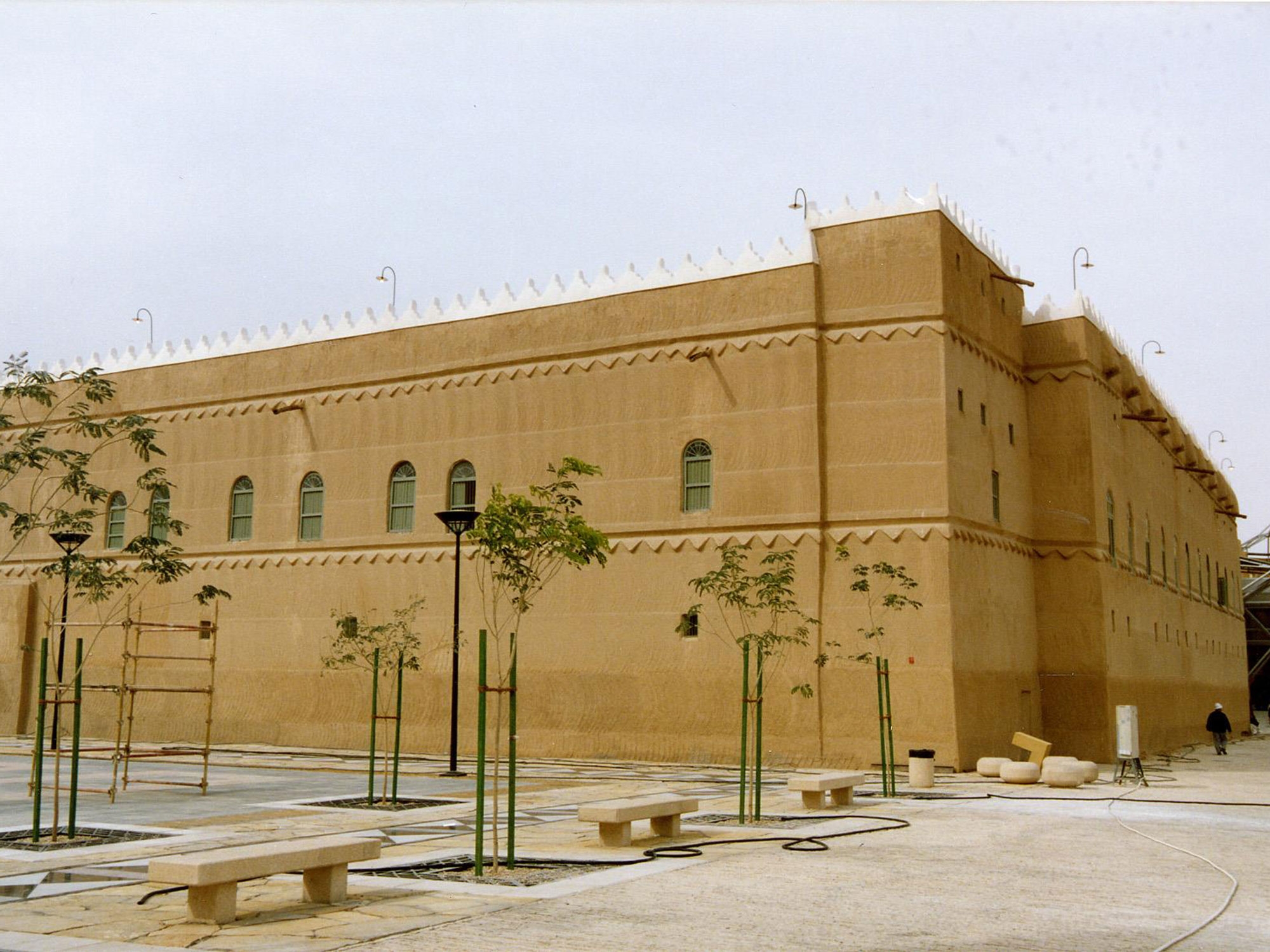
Museums: These institutions preserve the region's antiquities and heritage. In Riyadh City, notable examples include the Saudi National Museum, opened in 1999 and located on the eastern side of the King Abdulaziz Historical Center; the Museum of the College of Tourism and Antiquities at King Saud University, established in 1959; the Currency Museum in the main building of the Saudi Central Bank; Saqr al-Jazeera Aviation Museum; and the Historic Masmak Palace Museum, which recounts the history of King Abdulaziz Bin Abdulrahman Al Saud and his efforts in unifying Saudi Arabia.
Antiquities in the Eastern Province
The antiquities in the Eastern Province are diverse, including:
Thaj Archaeological Site: Considered the largest archaeological site in the eastern part of Saudi Arabia, it is the only ancient city on the eastern coast of the Arabian Peninsula and one of the historic Arab kingdoms dating back to the pre-Islamic era.
Thaj Historical City is located ninety km west of al-Jubayl City. It features numerous writings, drawings, and Hassawi inscriptions. An archaeological burial site dating back to the Hellenistic period was discovered there, containing gold necklaces and coverings, as well as a small statue of a girl. The statue dates back to the first century and stands forty-six cm tall. The city's settlement dates to the Stone Age and flourished during the period around 322 BCE. and the first century CE.
Jawatha Historical Mosque: Located in al-Ahsa Governorate, it was built by the Banu Abd al-Qays tribe after their conversion to Islam in the seventh year of Hijrah. It is the second mosque in Islam where Friday prayers were held, after the Prophet's Mosque.
The Historic al-Uqayr Port: Located in al-Hufuf, affiliated with al-Ahsa Governorate, it served as the gateway to the center of Saudi Arabia and an economic hub for the state before the establishment of King Abdulaziz Port. Its historical significance led to the registration of its customs building in the National Antiquities Register.
Tarut Castle: Situated atop a hill in the center of Tarut Island, it is currently located within the southwestern area of "al-Deirah," the name given to the old town of the archaeological Tarut Village in the eastern part of Qatif Governorate. The history of the Tarut Hill, on which the castle was built, dates back to the fifth millennium BCE.
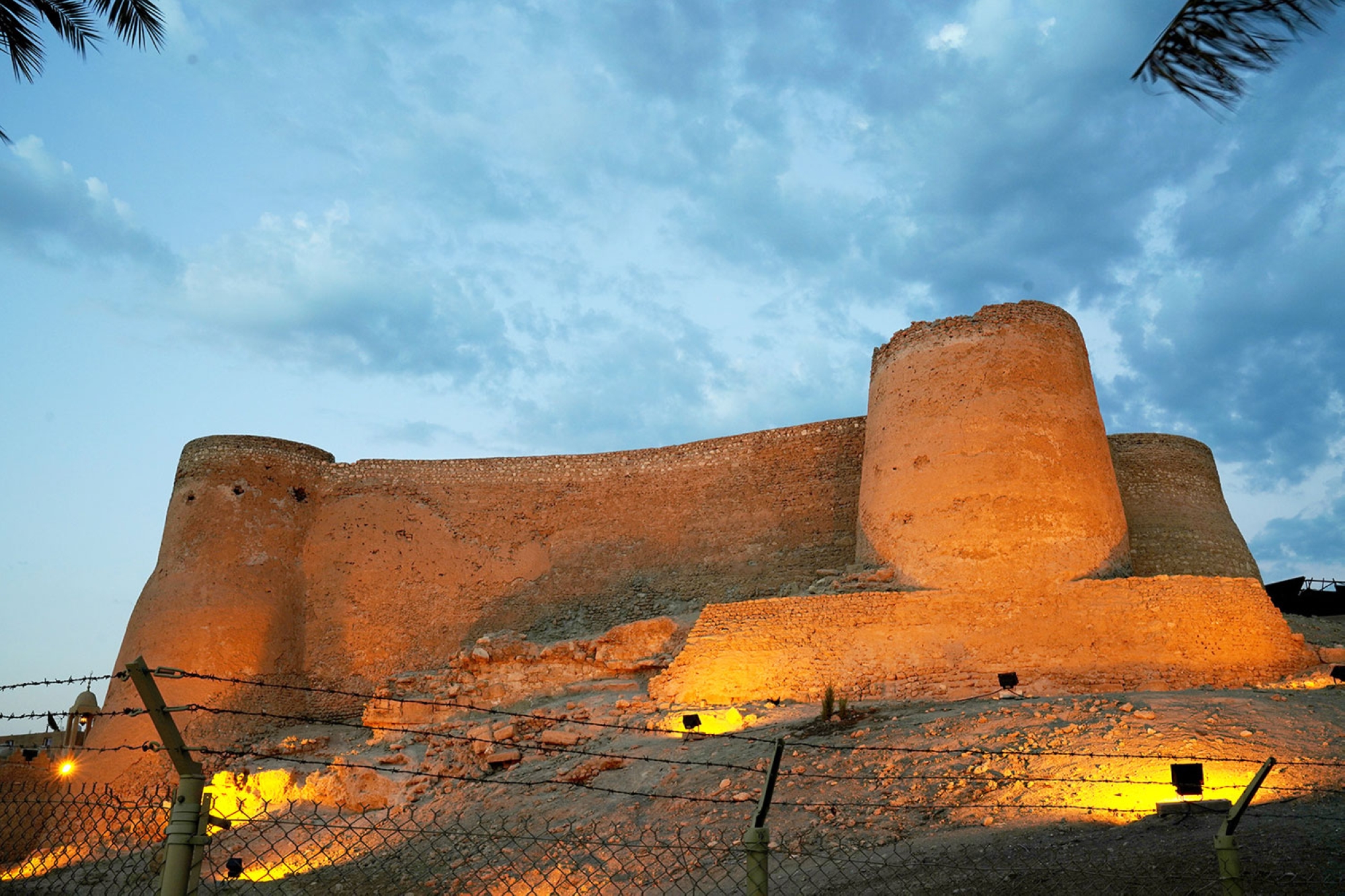
The Eastern Province also contains several historical palaces, including:
Ibrahim Archaeological Palace: Built in 1555, it is one of the archaeological landmarks in al-Hufuf. Its architecture reflects a blend of contemporary Arab-Islamic style and includes several military structures.
Sahoud Palace: Built in the thirteenth century in al-Mubarraz City, it is surrounded by a high wall featuring seven watchtowers. The palace includes a mosque, a well, a cellar, horse stables, several rooms, and an open courtyard. It was named Sahoud after a large cannon that was installed there.
Bayt al-Bay’ah (House of Allegiance): One of the significant landmarks in the Eastern Province, it witnessed the allegiance of the people of al-Ahsa to King Abdulaziz Bin Abdulrahman Al Saud on May 5, 1913. The construction of Bayt al-Bay’ah dates back to 1789.
Museums: The Eastern Province is home to several museums that have contributed to introducing visitors to the province's history and antiquities, showcasing a variety of artifacts. Among these museums are al-Ahsa National Museum, al-Buo'baid Museum, and al-Ahsa House Museum "al-Naathel".
Antiquities in Makkah al-Mukarramah Province
Makkah al-Mukarramah Province is distinguished by its diverse Islamic antiquities, among which are:
The Prophetic Migration Route: It begins from Thawr Cave, south of Makkah al-Mukarramah City, and extends to Quba in al-Madinah al-Munawwarah.
Zamzam Well: Located within the Grand Mosque in Makkah al-Mukarramah, near al-Kaaba al-Musharrafa, it is the source of Zamzam water.
Ain Zubaidah Endowment: It dates back to the Abbasid era and is named after Zubaidah Bint Ja'far Bin Abi Ja'far al-Mansur, the wife of the Abbasid Caliph Harun al-Rashid.
Archaeological and historical Mosques: Makkah al-Mukarramah Province is rich in archaeological and historical mosques, including al-Bay'ah Mosque, built at the site of the first pledge of allegiance in Islam; al-Jinn Mosque; al-Ji'ranah Mosque; and at-Tan’im Mosque, also known as Masjid Sayyidah Aisha, which is the nearest Miqat for pilgrims from Makkah. Additionally, it is home to many other mosques, such as ar-Rayah, as-Sakharat, al-Mash'ar al-Haram, Namirah, and al-Mursalat.
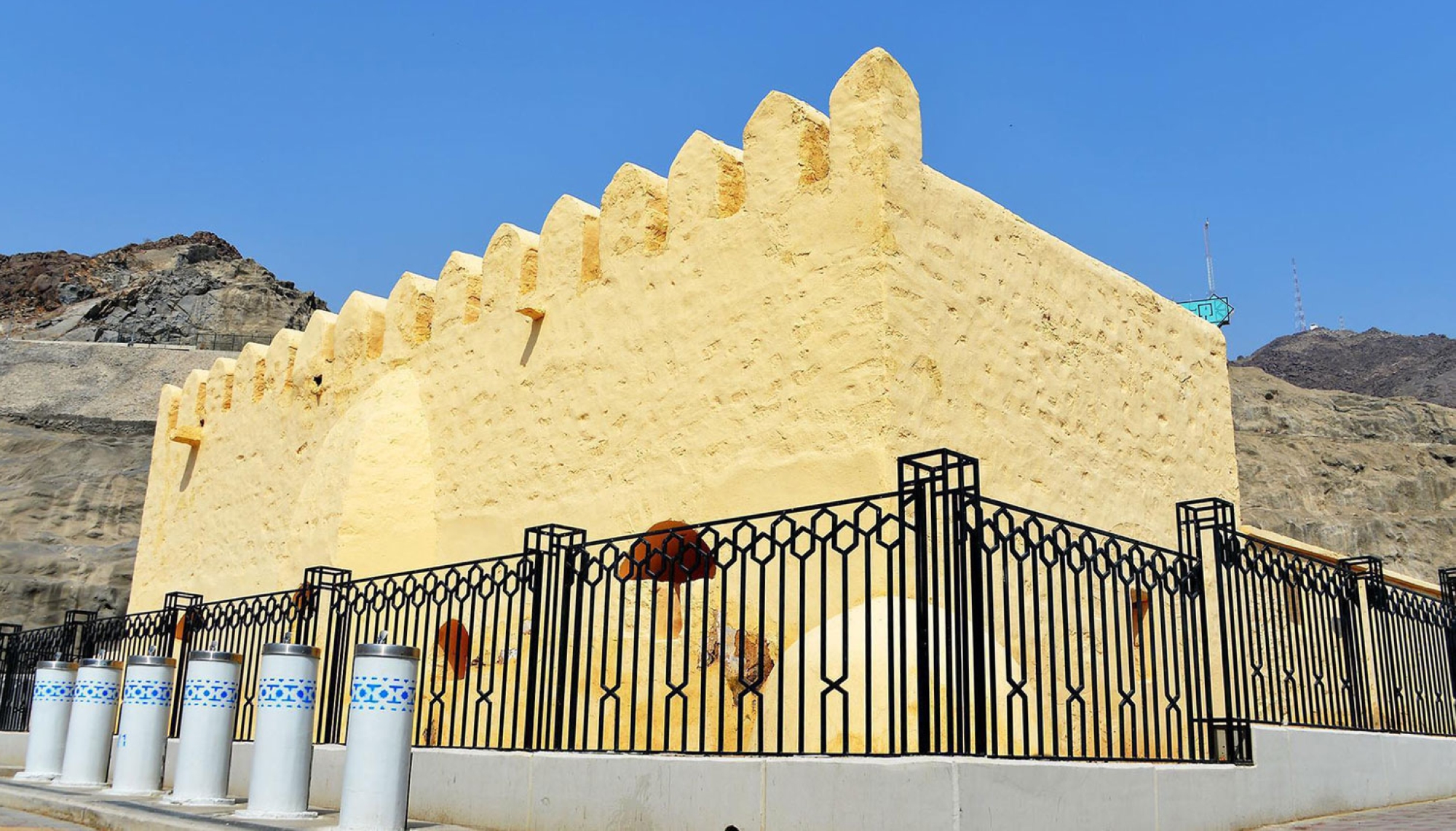
Forts, palaces, and castles: These are scattered across the Makkah al-Mukarramah Province and its governorates, including Shanqal Fort in Turbah Governorate; Qishla Jeddah and Qishla Makkah; the Historic Asfan Fort; the Historic Shubra Palace in Taif Governorate; the Royal Palace in al-Ma’abidah in Makkah al-Mukarramah; and Khuzam Palace in Jeddah Governorate, which has been transformed into the Jeddah Regional Museum.
The archaeological al-Sirin Port on the Red Sea Coast: Built in the pre-Islamic era, al-Sirin, located south of Makkah al-Mukarramah, 245 km away, and 220 km from Jeddah Governorate, was a vital and economically active site from the ninth century to the fourteenth century.
Antiquities in al-Madinah al-Munawwarah Province
Al-Madinah al-Munawwarah Province is distinguished by its Islamic antiquities and landmarks, with some of its archaeological sites dating back to the Neolithic, Chalcolithic, and Early Stone Ages. Numerous cairn tombs, stone alignments, stone circles, rectangular formations, and towers have been discovered, indicating ancient human settlement in these areas. Additionally, hundreds of rock drawings are scattered across the province, providing significant insights into life, the environment, and human activity in ancient times.
Ancient inscriptions and rock art: These are primarily concentrated in volcanic fields, oases, along ancient trade routes, and valley passages. Notable sites featuring rock art include as-Suwaydira, al-Hanakiya, alUla Governorate, and the northern area of Hegra.
Al-Baqi Cemetery: Also known as al-Baqi al-Gharqad, it is located opposite the southeastern section of the Prophet's Mosque. It serves as the main cemetery in al-Madinah al-Munawwarah and contains the graves of approximately ten thousand companions of the Prophet.
Mount Uhud: Located five km from the Prophet's Mosque, it is home to the Cemetery of the Martyrs of Uhud, who fell in the Battle of Uhud. The mountain also contains the Cave of Uhud and is adjacent to Jabal ar-Rumah (the Archers' Mount), also known as Jabal Aynayn.
Historical mosques: Al-Madinah al-Munawwarah Province is home to many historical mosques, some of which date back to the time of Prophet Muhammad, peace be upon him (PBUH). These include Quba Mosque, al-Ghamama Mosque, al-Ijabah Mosque, al-Qiblatain Mosque, as-Sajdah Mosque (also known as ash-Shukr Mosque), al-Jumu’ah Mosque, al-Miqat Mosque (also known as ash-Shajarah Mosque), and as-Saqya Mosque.
Saqifah of Banu Sa’idah: A historical landmark of Islamic history, it was a roofed structure made of tree trunks and palm fronds, enclosed on three sides. It was located in the northwestern area of the Prophet’s Mosque, within a farm surrounded by the adjacent orchards and homes of Banu Sa’idah. A well belonging to Banu Sa’idah was also nearby. The Saqifah was later transformed into a structure that underwent various changes over the centuries. It is now a garden that directly overlooks the western wall of the Prophet’s Mosque.
Dhabi Road or al-Jassah Road: One of the historical landmarks in al-Madinah al-Munawwarah Province, it is the path Prophet Muhammad (PBUH) took when entering al-Madinah al-Munawwarah during his migration. The road passes east of Jabal Ayr, leading to al-Usbah area and then to Quba.
Thaniyat al-Wada: Located north of the Prophet’s Mosque, it is one of the sites closely associated with the history of al-Madinah al-Munawwarah. A "Thaniyah" refers to a mountain pass, and this site served as the place where travelers were bid farewell.
Historical Wells: Al-Madinah al-Munawwarah is renowned for its historical wells, some of which date back to the Prophetic era. Among these is Khatam Well, located to the west of Quba Mosque and also known as Aris Well, and Faqir Well, attributed to the companion Salman al-Farsi (may Allah be pleased with him), situated within the historic Faqir Farm. Additionally, Ghars Well and al-‘Ihn Well are located in Wadi Bathan in al-‘Aliyah Province, while ‘Adhq Well is where Prophet Muhammad (peace be upon him) and Abu Bakr as-Siddiq (may Allah be pleased with him) rested upon their arrival in al-Madinah. Another significant well is Rumah Well, also known as the ‘Uthman Well, attributed to the third Caliph ‘Uthman Bin ‘Affan (may Allah be pleased with him).
Dar al-Madinah Museum for Urban and Civilizational Heritage: Located in the eastern part of al-Madinah al-Munawwarah within the premises of Knowledge Economic City, it is the first museum dedicated to the history and heritage of al-Madinah. The museum features a collection of models, photographs, publications, and rare exhibits that illustrate a historical period spanning from the Prophetic migration to the Saudi era.
Antiquities in Northern Borders Province
The Northern Borders Province includes numerous archaeological sites, among which are:
Dawqara Archaeological Site: It is located northwest of Turaif Governorate. This site dates back to the pre-Islamic era, with its construction characterized by the use of large volcanic stones. It features an oval-shaped cistern surrounded by several archaeological mounds, a palace, three large stone columns, and some ancient inscriptions.
Linah Village in Rafha Governorate: It is one of the oldest human settlements in Saudi Arabia. It is home to King Abdulaziz Palace in Linah, which King Abdulaziz used as a headquarters for the emirate. The village also contains three hundred wells, some of which are still in use today.
Darb Zubaidah in Rafha Governorate is the oldest international route for pilgrimage and trade between Makkah al-Mukarramah and Iraq. Although its history dates back to pre-Islamic times, it is named after Lady Zubaidah, the wife of Caliph Harun al-Rashid.
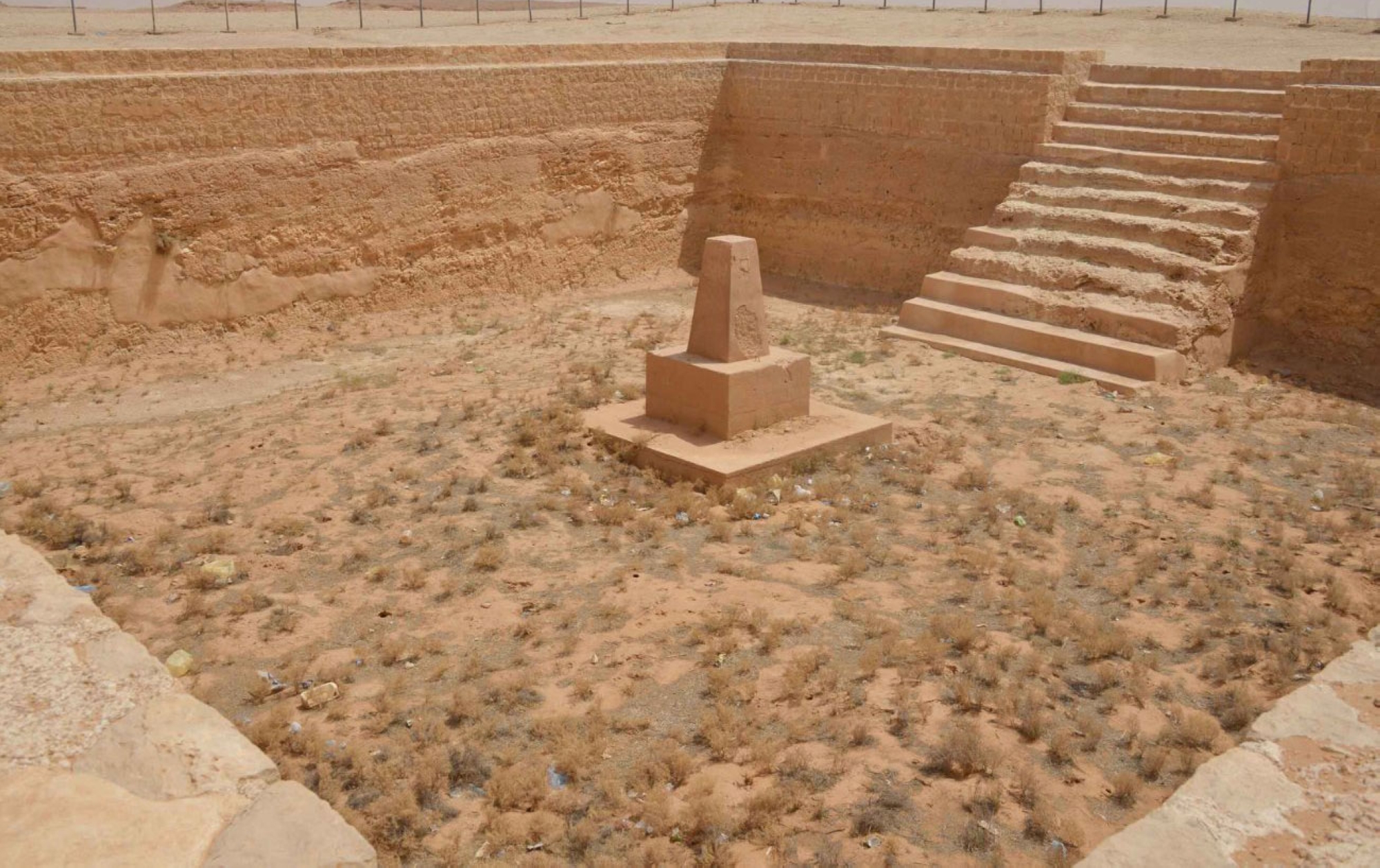
Antiquities in Qassim Province
Qassim Province contains several archaeological sites dating back to pre-Islamic times, including ancient inscriptions, carvings, and water resources carved into the desert. These are located in Uyun al-Jiwa Governorate, northwest of Buraydah City.
Qassim Province is distinguished by its archaeological and historical sites spread across its governorates, including towers, rocks, markets, museums, and mines.
Ash-Shinanah Tower is one of the archaeological landmarks located in ash-Shinanah, seven km southwest of ar-Rass Governorate. Built in 1757, it was used for reconnaissance and surveillance purposes. The area around the tower was the site of one of the battles led by King Abdulaziz Bin Abdulrahman Al Saud in 1904.
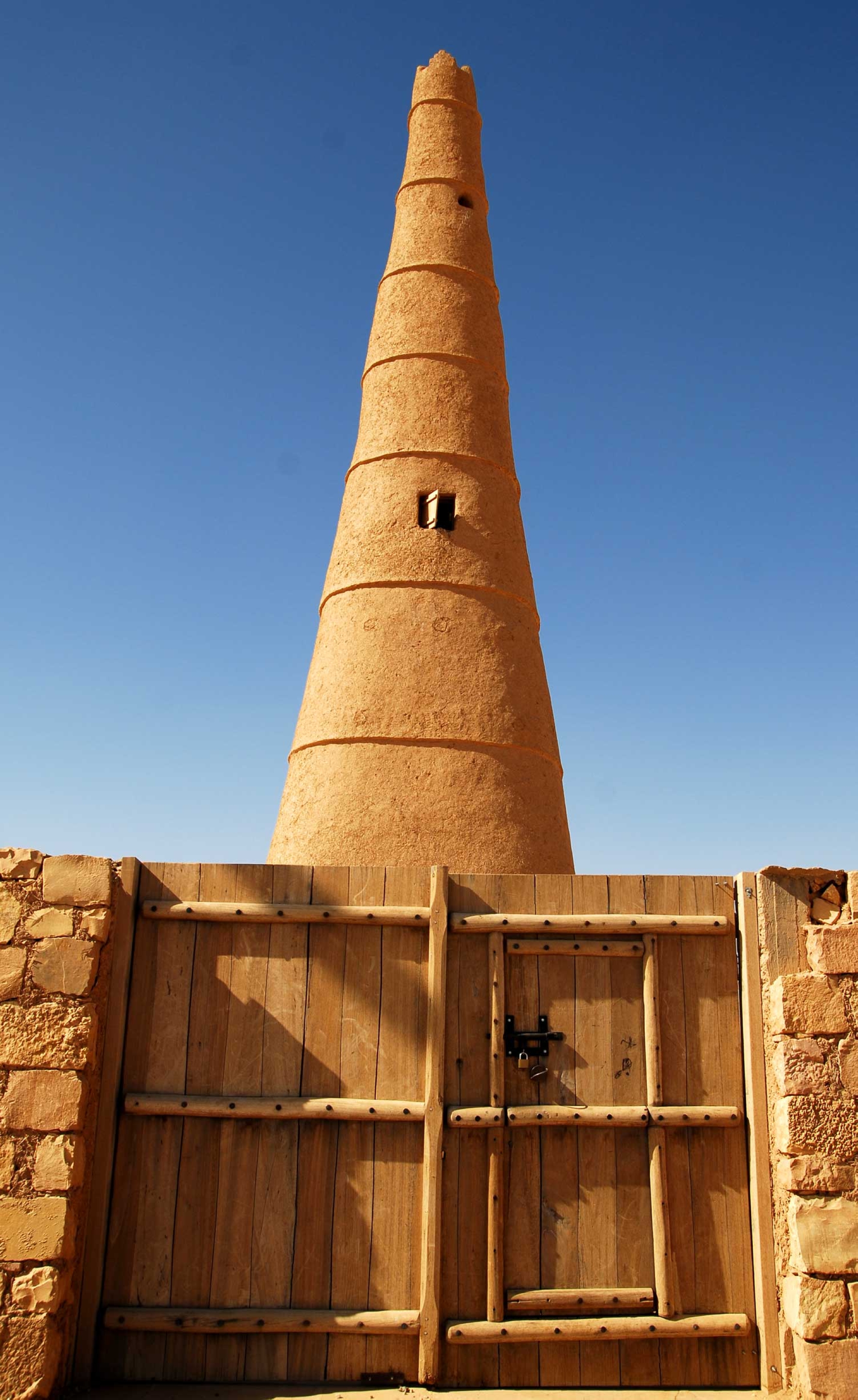
In Qassim Province, remnants of Islamic-era artifacts can be found, including the remains of mines in an-Naqrah Mountains, west of the province. Additionally, there are the historical ruins of ar-Rass, such as ash-Shinanah Watchtower and al-Khandaq, as well as the artifacts of Banu ‘Amir west of Aba al-Wurood, Hunaidhil, and al-Qawarah, along with some remnants of the Iraqi Pilgrimage Route.
Antiquities in Hail Province
Hail Province, located in the central northern part of Saudi Arabia, is home to archaeological sites, some of which date back to the Stone Age, as well as rock carvings and inscriptions dating to the seventh millennium BCE.
Rock carvings and inscriptions are widespread across cities in Hail Province, such as Jubbah and Shuwaymis, as well as al-Jildiyah, which features Thamudic inscriptions and depictions of humans and animals. Al-Ha'it, historically known as Fadak, includes numerous ancient forts and castles and is considered one of the largest archaeological sites in the region. In al-Huwayyit, previously known as Yadi', there are Thamudic inscriptions and Kufic writings dating back to the eighth century. Other archaeological sites are located in al-Shamli, Aba al-Saban, Sabhah, Tuwal al-Nufudh, al-Ghutah, al-Qa’id, Qibaa, al-Milayhyah, and Yatib.
Janin Mountain is located approximately seventy km northeast of Hail City. It is characterized by rock faces adorned with human and animal carvings and inscriptions. The mountain also contains a settlement cave about fifty m long, with human handprints and marks on its walls.
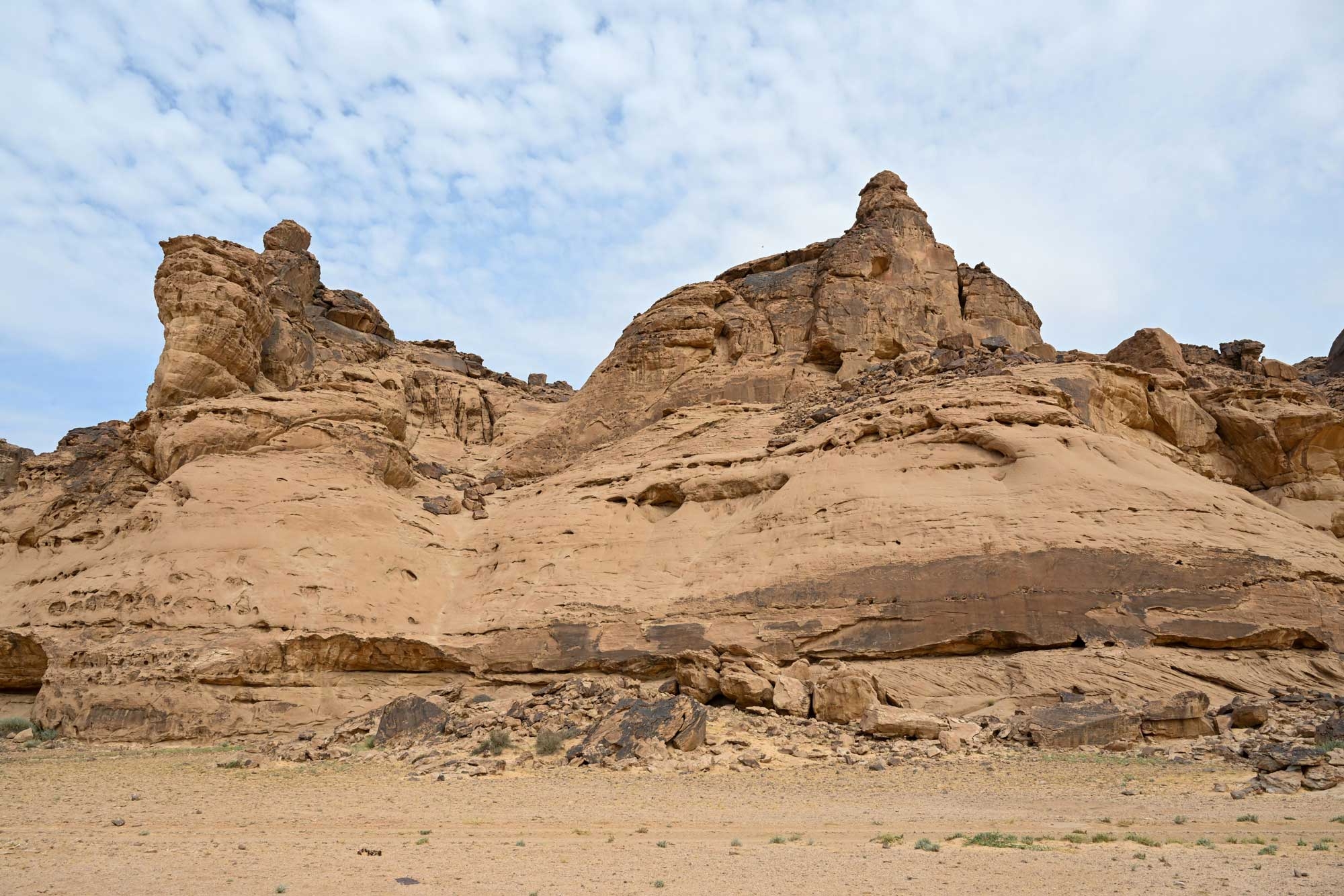
Hail Province includes the historical Jal’ud Mosque, one of the ancient mosques along the Makkah-Kufah Pilgrimage Route. It is located in the old town south of Samirah City, approximately 120 km southeast of Hail.
Approximately thirty-two Islamic archaeological sites have been documented in Hail Province, several of which are located along the Iraqi Pilgrimage Route. These include al-Hajiz, also known as al-Ba’ayith, Harid, Samirah, al-Makhruqah, al-Ghuraybin (or al-Qara'in), Fayd, East Sayt, also referred to as ancient Zarud, and al-Bad' Station.
Antiquities in Tabuk Province
Tabuk Province is home to several archaeological landmarks, including:
The ruins of al-Bad' Oasis: Known as Magha’ir Shuaib or Mada'in Shuaib, these ruins date back to the Nabataean period. They include sixteen tombs, each containing several burial niches carved into the rock, some adorned with ancient decorations resembling the façades of Nabataean tombs found in the city of Hegra. The oasis also features the well from which Prophet Moses (PBUH), drew water for the livestock of Prophet Shuaib.
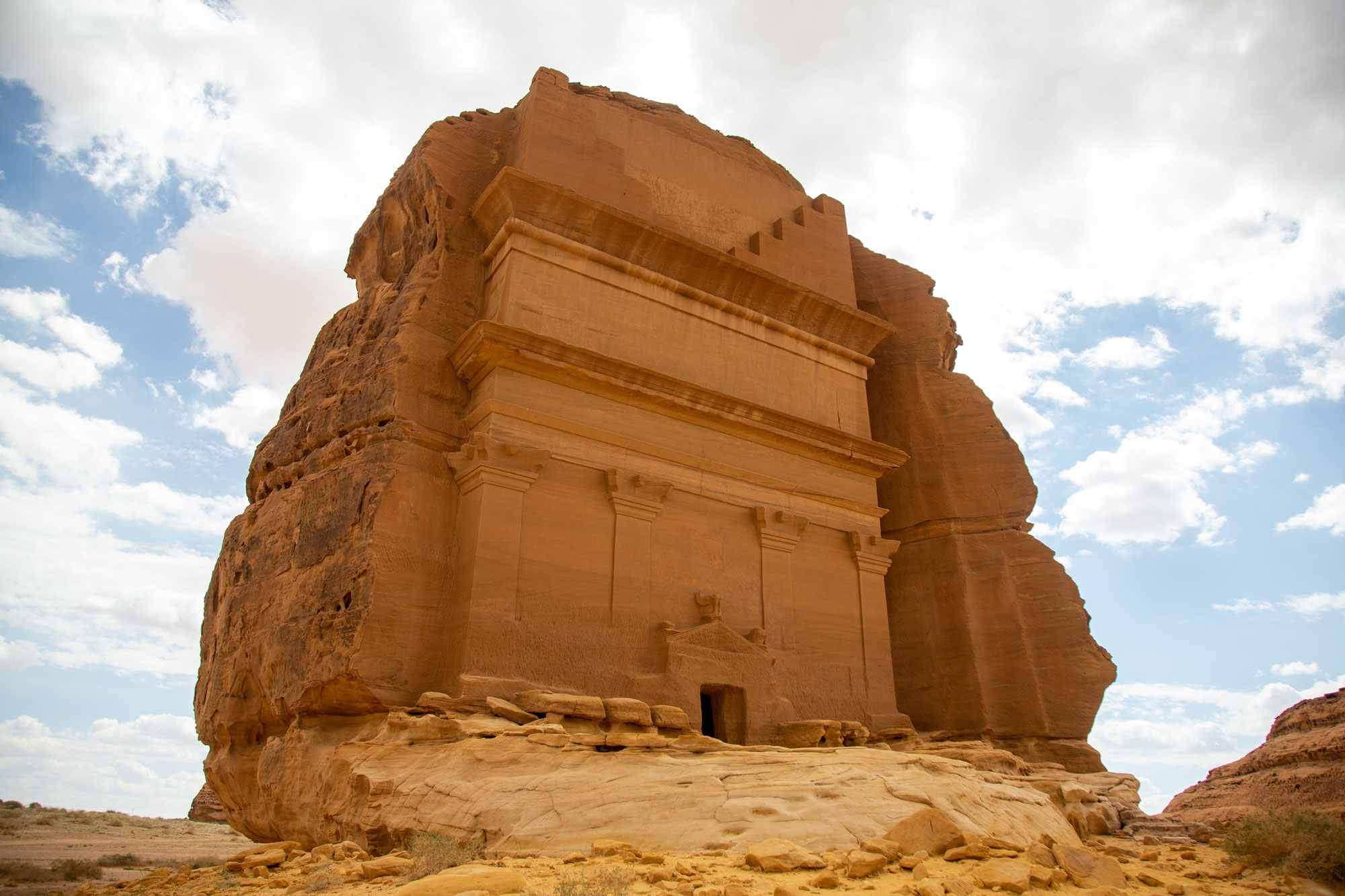
The Great Ancient Wall in Tayma Governorate: This wall stretches approximately ten km, with its remaining sections reaching a height of up to ten m. Its width ranges between one and two m. The wall dates back to the sixth century BCE. Within the wall lies the archaeological site of al-Bajidi, a stone structure resembling a large palace surrounded by an outer wall. It consists of residential units and four towers positioned at its corners.
The historical palaces in Tayma City: include al-Hamra Palace, located northwest of the city, dating back to the mid-sixth century BCE. Additionally, there is al-Radum Palace, situated west of Tayma, also known as "al-Ablaq" due to the white and red hues of its construction. It was also called "al-Fard" for its unparalleled uniqueness during its time.
Antiquities in al-Jawf Province
Al-Jawf Province is among the richest provinces in Saudi Arabia in terms of historical sites, including:
Ash-Shuwayhitiyah Archaeological Village: One of the oldest human settlements, located forty-five km from Sikaka City. Its historical roots trace back to the Oldowan era of the Paleolithic period. Numerous stone tools were collected from the site, estimated to be 1.3 million years old, making it the earliest known human settlement in the Arabian Peninsula.
Columns of Rajajil: An archaeological site dating back to 7,000 BCE, located ten km from Sikaka City. The site is named as such because the columns, when viewed from afar, appear as a group of men. Some of the columns are broken, while the standing ones reach a height of approximately three m. Stone tools such as scrapers, awls, and various stones were discovered at the site, but no evidence of human habitation was found.
Sisra Archaeological Well: Located in Sikaka City, it dates back to the Nabatean period. The well is carved into the rock, measuring eight by nine m with a depth of fifteen m. It features a staircase carved into one of its sides descending into the well.
Za'abal Fortress: One of the ancient historical fortresses in the Arabian Peninsula, its current structure dates back to the seventeenth century, with renovations completed in the nineteenth century. Its original construction predates Islam and is believed to have been built on the ruins of Sisra Fortress, which dates to the first century BCE. The fortress is located in the northwestern part of Sikaka City and is constructed from stone and mud. It features four towers, one at each corner, which were used for surveillance and for protecting the trade route that passed through the city.
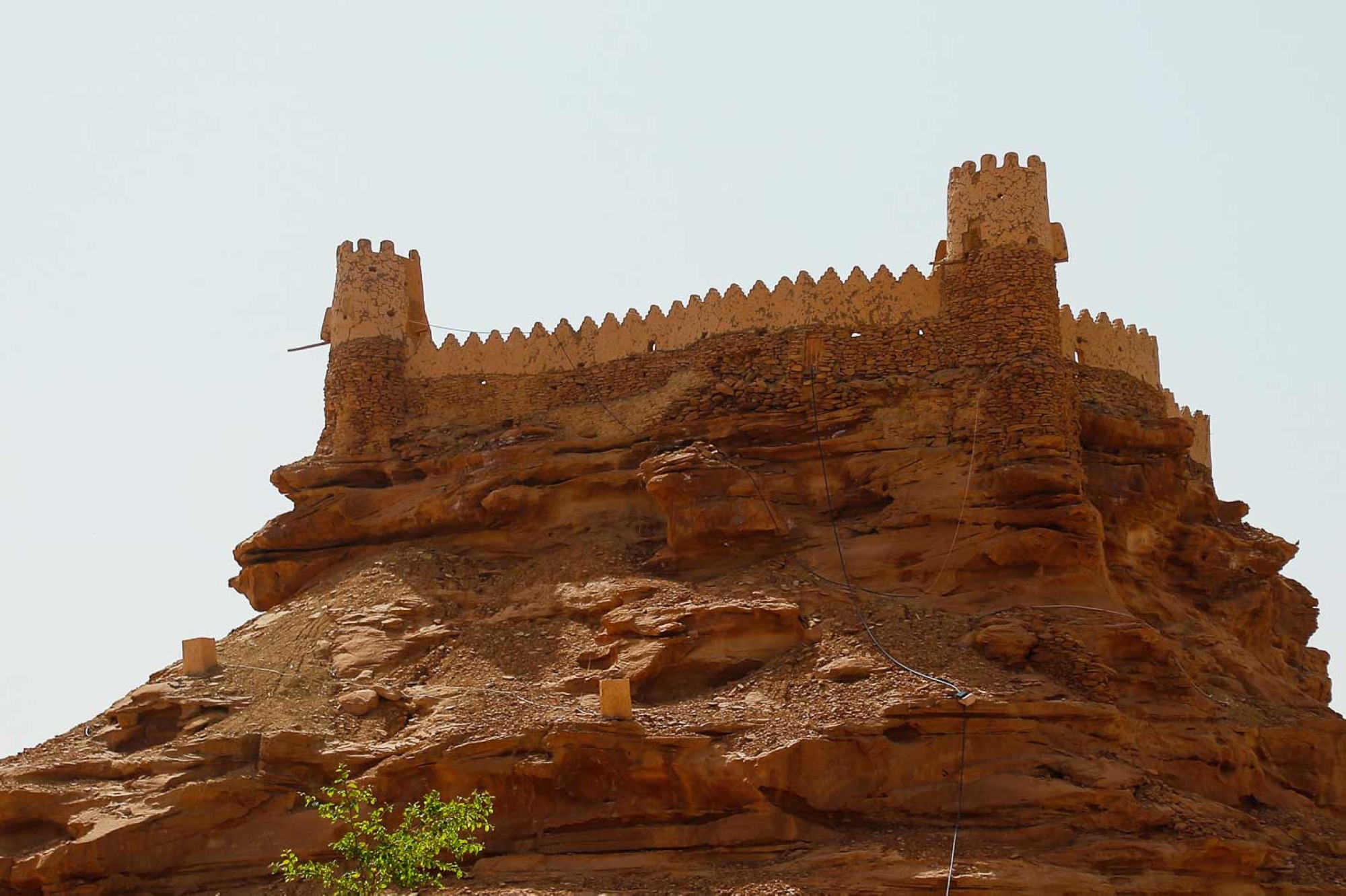
Marid Castle: Located in Dumat al-Jandal Governorate, it is one of the most significant archaeological castles in the north of Saudi Arabia. The earliest mention of the castle dates back to the third century when Queen Zenobia of Palmyra besieged it but failed to conquer it. The fortress, which is walled, stands on a high hill overlooking the old city of Dumat al-Jandal. Some parts of the fortress were reconstructed due to their age, while the larger portion remains in its original state. Inside the fortress are several rooms, and it features four towers at its corners, which were used for surveillance. At the base of the fortress lies a deep well, and additional annexes and rooms were added after its original construction.
Dumat al-Jandal Wall: Located on the western edge of Dumat al-Jandal, it was discovered in 1986. The wall stands approximately 4.5 m tall and is constructed from stone in a style similar to Marid Castle. It features rectangular towers with two openings attached to the wall. The inner side of the wall is reinforced with a mud-brick structure.
The Mosque of Umar Ibn al-Khattab, may Allah be pleased with him, is one of the historical landmarks of Dumat al-Jandal. It is located in the heart of the old city of Dumat al-Jandal, adjacent to the southern side of Diriyah Neighborhood. It is believed that Caliph Umar Ibn al-Khattab ordered its construction during his journey through Dumat al-Jandal on his way to receive the keys to Jerusalem.
Kaf Palace: Situated near Mount al-Saidi, approximately fifteen km from al-Qurayyat Governorate, the inscription above its gate indicates that it was built on April 3, 1920, with an area of approximately 3,005 m². The palace consists of several structures, has been restored and fenced, and is considered a tourist landmark.
The Nabataean Ithera Palace: Located in Qurayyat Governorate, this square-shaped palace, measuring thirty by thirty m, lies west of Ithera Village and east of Kaf Village. Constructed from polished black basalt stones, the palace features an entrance gate on its northern side with an upper lintel made of a single rock. Above this lintel, a crescent shape is carved in relief, and above it, another stone bears a Kufic inscription consisting of four lines. These carvings and inscriptions indicate that the palace was used during the Islamic period in addition to the Nabataean era.
Antiquities in Aseer Province
Aseer Province in the southwest of Saudi Arabia encompasses numerous archaeological and cultural landmarks spanning thousands of years, some of which date back to the Himyarite civilization. Additionally, the foundations of two mosques were discovered, one of which dates to the Abbasid era.
The province is home to Rijal Heritage Village, located in Rijal Alma Governorate. This site is among Saudi Arabia's globally recognized heritage sites, listed on the tentative list for UNESCO World Heritage Sites.
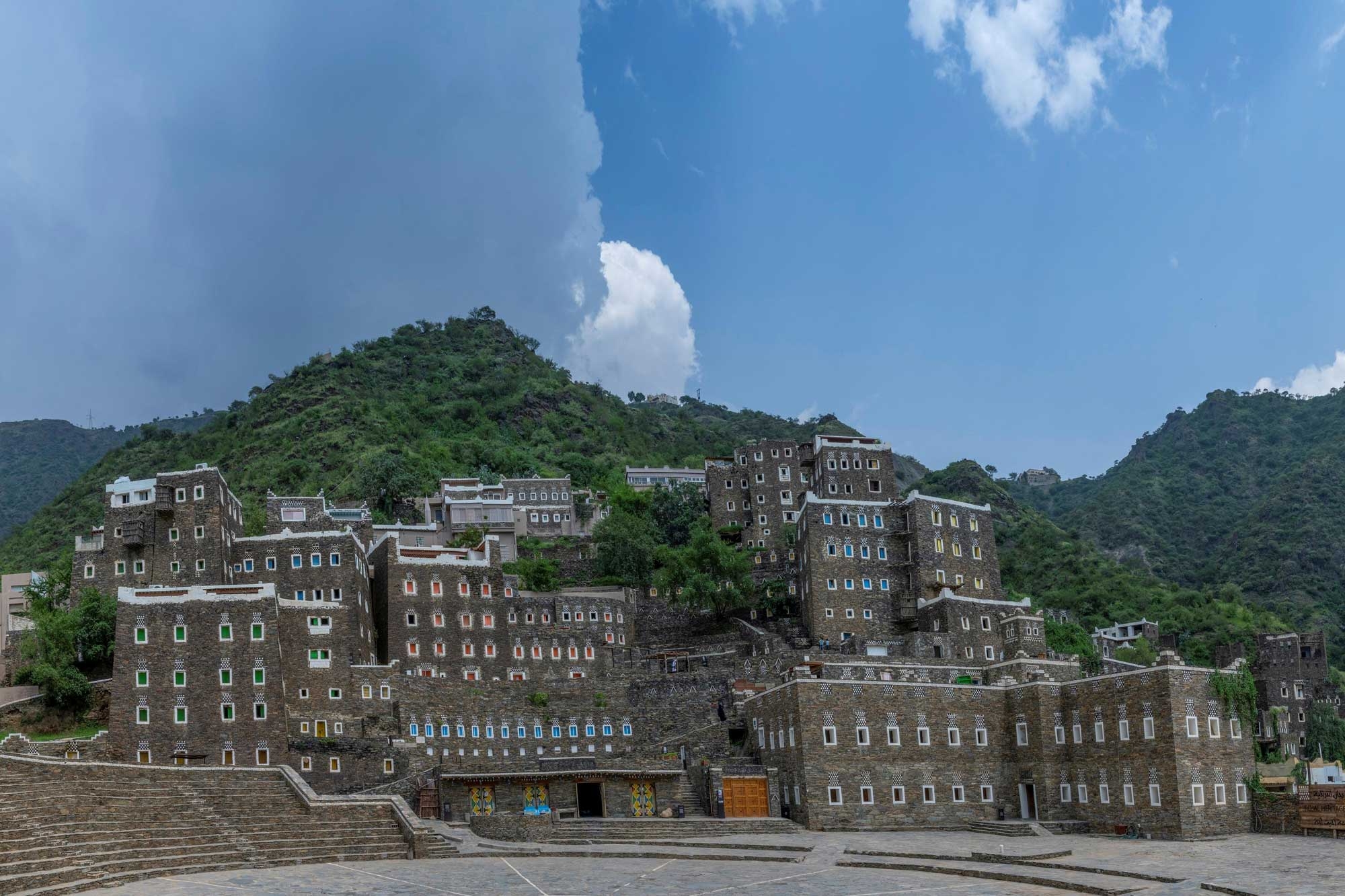
Aseer Province hosts a variety of heritage sites, including traditional markets, wells, agricultural terraces, fortresses, and mosques. It is one of the Provinces in Saudi Arabia known for its focus on constructing military fortresses and strongholds, a practice attributed to the availability of essential building materials such as stones and wood. Among these are:
Al Hayan Village Complex Site: This site features a rock engraved with depictions of horses and riders wielding spears, representing a battle scene. Surrounding rocks also bear carvings of human and animal figures.
Historical castles and palaces: These include Shada Palace in Abha City, which previously served as the emirate's headquarters; Shamsan Fortress; Dagl Fortress; Shaar Fortress, overlooking Aqabat Shaar; and Dhahban Palace in Khamis Mushayt Governorate.
Jurash Archaeological City: Located in Ahad Rufaydah Governorate, approximately fifteen km from Khamis Mushayt, between Hamoumah and Shakar mountains.
Al-Muftaha Village in Abha City: It features Tuesday Market, one of the oldest traditional markets in Aseer Province, previously known as Ibn Madhan Market before 1827.
Al-Abla Historical Center: Located at the upper part of Wadi Ranyah in Bishah Governorate, this site features remains of a mosque dating back to the early Islamic period, with an area of approximately 616 m². The center also contains archaeological treasures from the same era.
Antiquities in al-Bahah Province
Al-Bahah Province is distinguished by its historical forts, which date back approximately six hundred years. These forts served as protective structures and storage facilities for agricultural crops, safeguarding them from weather conditions and animal attacks. They were also used as repositories for farming tools and equipment. Among these forts are the Twin Forts, located in al-Malad Village, south of al-Bahah City, built at the beginning of the seventeenth century, as well as al-Amoudi Fort and al-Zahwan Fort.
Historical villages: These are spread across the cities of the province, with one of the most notable being Dhi Ayn Village, which dates back approximately four hundred years BCE, located approximately twenty-four km west of al-Bahah, perched atop a mountain. It consists of thirty-one houses, a small mosque, and several towers used for guarding. The village is renowned for its banana farms.
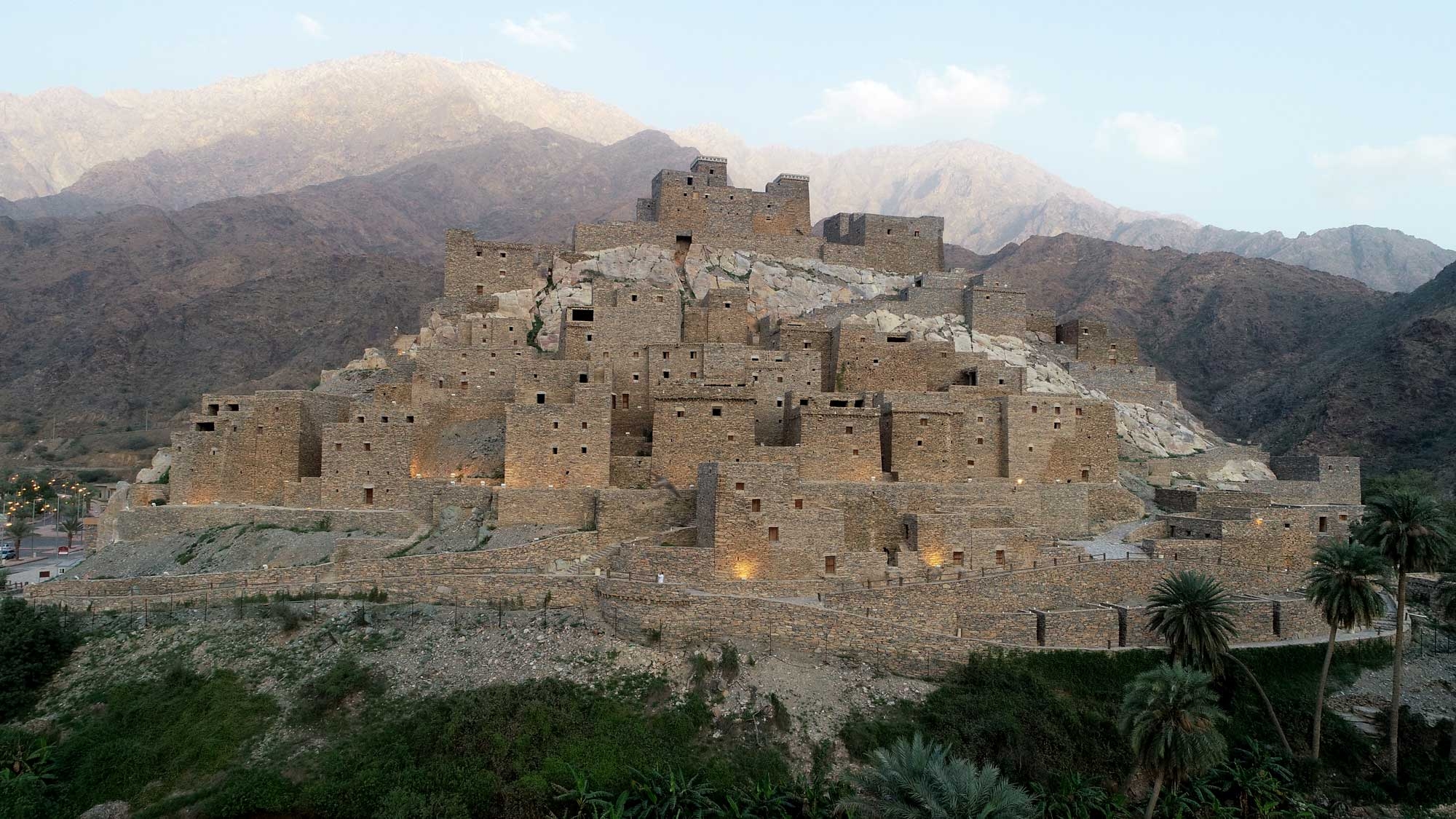
The sites of al-Khalf and al-Khaleef: Located in Qilwah Governorate, their history dates back to the ninth century. The two adjacent towns are separated by only two km and include houses, the remains of a mosque, graves, and other artifacts. Some of these have been reconstructed to preserve the Kufic inscriptions carved on them, which date from the early ninth century to the mid-eleventh century.
The Old Pilgrimage Route: It passes through the province, with remnants such as ash-Sham Village, which is believed to have been inhabited before Islam and was renowned for its mines. The village was mentioned by Yaqut al-Hamawi and Shams al-Din al-Maqdisi in their historical works. The archaeological remains of the village are spread over an area of approximately 1,500 km² and include houses, graves, ancient Arabic Kufic inscriptions, and pottery dating back to the early Islamic period and earlier.
Antiquities in Jazan Province
The archaeological sites in Jazan Province vary between ancient cities and towns, forts, houses, mosques, rocks, columns, pottery, inscriptions, carvings, and decorations.
The Farasan Islands, part of Jazan Province, feature numerous archaeological sites, including Jabal Luqman, composed of collapsed stones indicating the presence of an ancient fortress, with nearby old cemeteries. Additionally, Beit al-Jarmal is located on Qummah Island, alongside several other historical houses. Wadi Matar, in the southern part of Farasan Island, contains large rocks inscribed with Himyarite script. The heritage village of al-Qassar is situated on the southeastern edge of the Red Sea, approximately forty km from Jazan City. This village dates back roughly nine thousand years and comprises around four hundred houses built from stone and clay.
Jazan Province is renowned for its fortresses, including ad-Dosariah Fortress overlooking the Red Sea. It is located atop a mountain in the center of Jazan City at an elevation of approximately two hundred m, indicating its historical role as a surveillance point. Other notable fortresses in the province include al-Hima Fortress and al-Khatm Fortress.
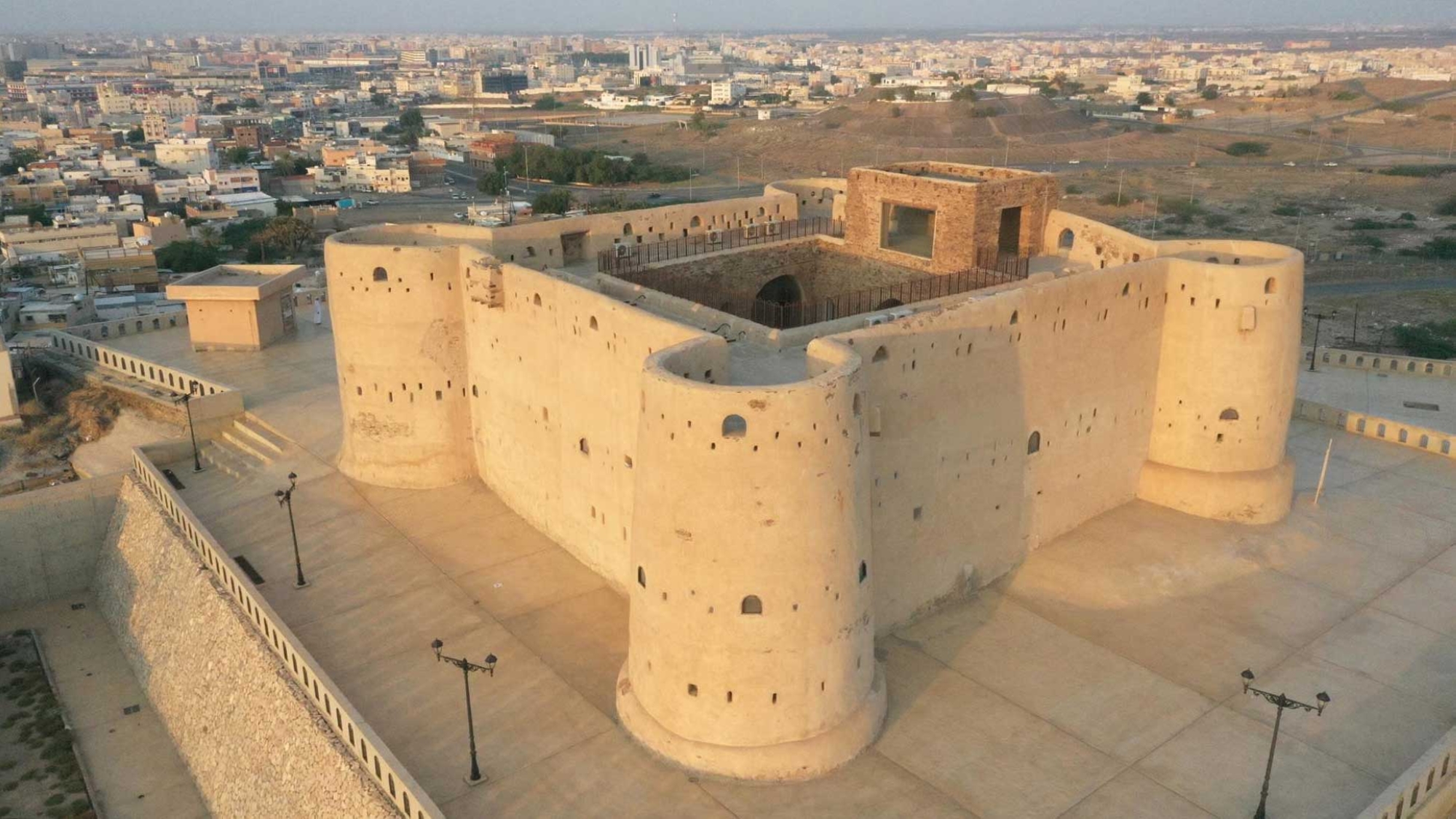
Antiquities in Najran Province
Najran Province is home to al-okhdood Archeological City, whose story is mentioned in the Quran, along with approximately one hundred archaeological sites. At al-okhdood site, a pottery jar containing one thousand coins was discovered, along with metal seals and stones inscribed with the ancient South Arabian Musnad script, dating back to the first century.
Najran Province boasts inscriptions, carvings, and writings from various historical periods. Notable sites include Jabal al-Dhira’ in the Saqam area, Jabal al-Musamma, Bir Hima, Qarn al-Zafran, and the ruins of ad-Durayb, among others.
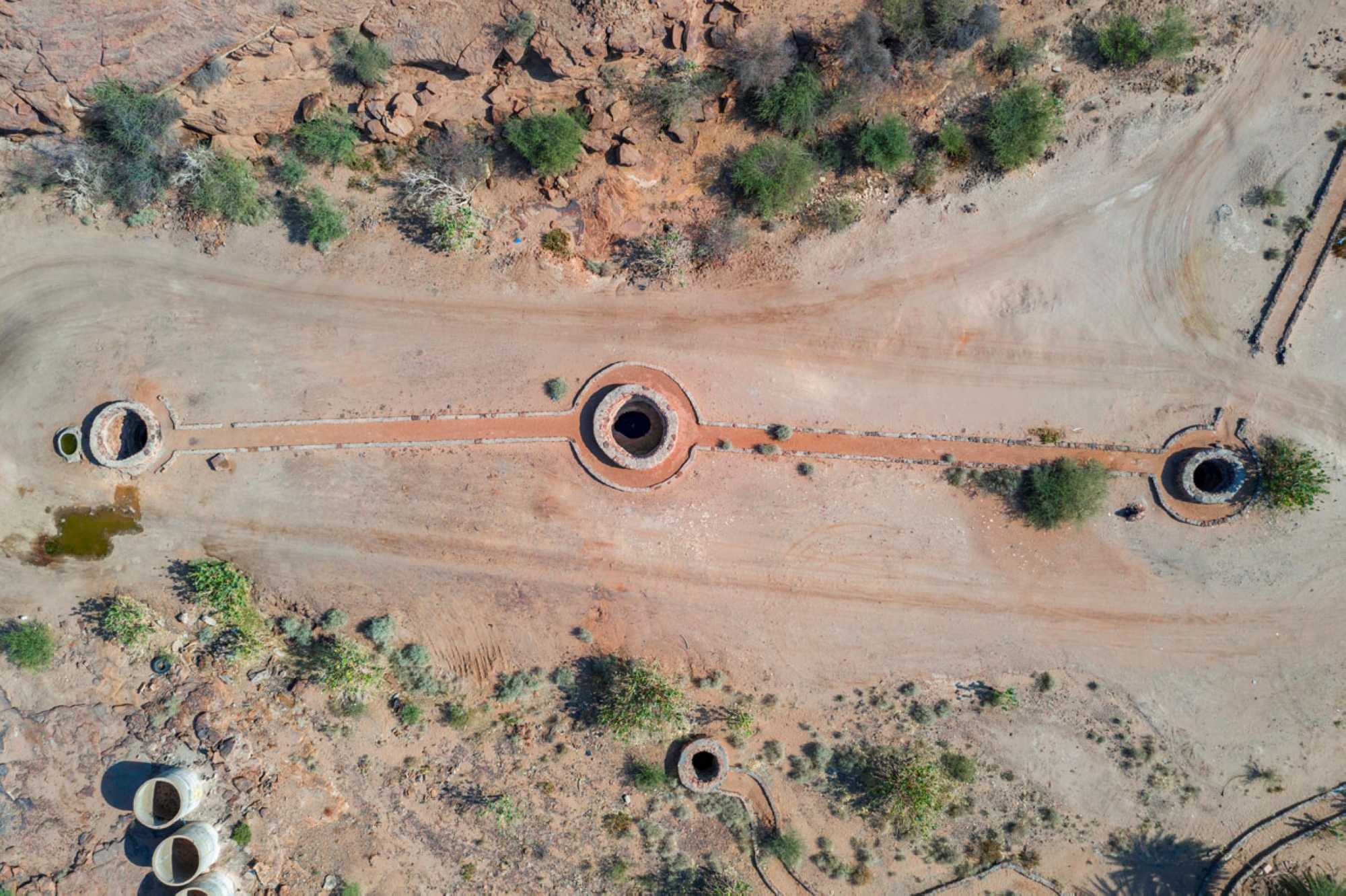
Najran Province also features several historical neighborhoods, such as the historic Aba al-Saud neighborhood, which includes several traditional and heritage markets. These markets offer artisanal and historical crafts that Najran Province is known for, such as daggers, Jambiyas, leather goods, textiles, stoneware, and pottery.
The diversity of archaeological sites in Saudi Arabia
Caves and harrat in Hail Province
These are archaeological sites that distinguish Hail Province, located in the central northern part of Saudi Arabia. They are historical landmarks, with approximately ten caves and twelve volcanic craters discovered so far.
There are archaeological sites in the caves and remnants of volcanoes in Hail Province, including:
Shaafan Cave: Located on the edge of Harrat al-Nar, the cave overlooks its vast volcanic crater. It is one of the largest caves in Saudi Arabia, with a length of two km, a height of eight m, and a depth reaching eight hundred m below the surface. The cave contains winding side paths, the full extent of which remains unknown. There are also other caves in the province comparable to Shaafan in size, historical significance, and archaeological value.
Ash-Shuwaymis: Distinguished by its location amidst mountains that surround it from all sides, the area features valleys, ravines, and fertile grazing lands. It is also rich in mountains and caves adorned with archaeological inscriptions, including:
Harrat al-Nar: This archaeological site was discovered in 2001 by local Bedouins who observed carvings on the mountains. Subsequent studies revealed that these engravings date back approximately 14,000 years. Historical sources indicate that volcanic activity occurred in Harrat al-Nar prior to the Prophet Muhammad's (PBUH) mission, with records in Arab writings noting an eruption during the caliphate of Umar Ibn al-Khattab. Access to this site is challenging, requiring guidance from local inhabitants familiar with the area.
Archaeological graves of Dhahran
The Archaeological Graves of Dhahran is one of the heritage sites in the Eastern Province, located south of Dhahran City. The graves date back to three distinct periods, with the oldest tracing its origins to the third millennium BCE. The second period begins with the start of the second millennium BCE, and the site's use continued throughout this period until the end of the sixth century CE.
The Archaeological Graves of Dhahran site served as a station along an ancient caravan route connected to an old seaport in Dhahran. This ancient route, whose remnants are still visible today, links to the settlement of Ain as-Saih to the south. The site also includes a settlement dating back to the third millennium BCE, adjacent to a burial mound field containing nine hundred graves. Excavations have revealed that some of these graves were looted during various historical periods.
The artifacts discovered at the site highlight a rich and diverse collection, including a wide range of pottery, metal items, bracelets, rings, decorative jewelry, beads, and seals.
The site also revealed a variety of pottery types, including simple vessels such as cylindrical jars, pear-shaped vessels, ribbed pottery, Berber-style pottery, sandy pottery, and burnt gray pottery. Large quantities of colored pottery were uncovered as well. Additionally, diverse collections of beads in various shapes were found, including cylindrical, convex, conical, spherical, and hexagonal designs, as well as Chinese and shell beads.
Ruins of Duba Valley
The oldest of these archaeological sites in the valley dates back to the first three centuries of the Hijri calendar, documenting the history of the western Arabian Peninsula during that period.
In Wadi Duba, there are distinct archaeological sites, including inscriptions and texts written in Kufic script visible at the upper part of the valley, dating back to the eighth and ninth centuries. Among the now-vanished relics is a site that once held seven freshwater wells, dating to the early eleventh century. Additionally, in the southwestern part of Wadi Duba, there is a small water basin referred to in historical documents as Birkat al-Fasqiyah.
Aynuna Ruins
It is a collection of archaeological evidence scattered across various sites in Wadi Aynuna in Tabuk Province, serving as one of the key archaeological landmarks that document the region's history during the early Islamic eras and pre-Islamic periods.
The site of Aynuna holds both historical and future significance. In addition to being home to ancient civilizations, it is currently part of the future NEOM project.
The Islamic antiquities in Wadi Aynuna can be divided into two main sections. The first section represents the site that marks the return journey of pilgrims coming from Makkah al-Mukarramah. This site belonged to a small village historically referred to in sources as a stop on the pilgrimage route, known as "Hadrat Oyoun al-Qasab." Today, the village is in ruins, with only remnants remaining. The other archeological section is on the route of the outward journey of hajj caravans heading toward Makkah al-Mukarramah. This site is a spacious land, higher than the valley stream.
Aynuna was originally an inhabited oasis dating back five thousand years, historically known as "Leuke Kome," meaning the White City. It occupied part of the land of the People of the Thicket (Ashab al-Aykah) and continued its activity to become a major city in the Kingdom of Midian. It served as an economic hub for the transit of goods between Petra, the Nile River, and the southern Arabian Peninsula, and as a port for the Kingdom of Lihyan and later for the Nabatean state.
Wadi Aynuna was a trade center and a historic stop on the Egyptian pilgrimage Road, one of the most important houses on the coastal part of the road. During the Mamluk and Ottoman periods, it included tombs with domes and gravestones.
Aynuna Ruins are the vastest in the Nabataean archaeological site on the Red Sea coast in Saudi Arabia. In the past, Aynuna Port was the largest marina on the north coast of the Red Sea. It was the only marina that could accommodate the 130 ships that carried the army of Aelius Gallus.
Stone circles at the Tarim Site
The Tarim archaeological site within Tayma City features various types of stone circles, primarily concentrated southwest of the Tarim pool. These circles date back to the pre-Christian era. Among them is a large circle with a diameter of forty-six m, composed of granite stones with a height of half a m. Two smaller circles are connected to it, one of which has a diameter of four m. Additionally, the site includes separate stone circles, some of which are partially collapsed, appearing as piles or clusters of stones.
Saudi Arabia's efforts to protect archaeological sites
Archaeological sites in Saudi Arabia are safeguarded under the law, encompassing immovable, movable, submerged, and buried objects. Violators who damage, replicate, or unlawfully seize such artifacts are sanctioned. These sites and artifacts are considered public property of the state unless ownership is legally established by individuals. The law prohibits demolition, excavation for utility installations, construction, or planting within the boundaries of these sites. Additionally, auctions for selling archaeological artifacts are banned in Saudi Arabia, except under specific circumstances and with licenses obtained from the relevant authority.
Role of the Heritage Commission in preserving and discovering archaeological sites
The Heritage Commission explores, preserves, and documents archaeological sites across Saudi Arabia, registering them in the National Antiquities Register. By 2024, approximately 9,317 archaeological sites had been documented in various provinces of Saudi Arabia.
Among its notable discoveries are the world's oldest stone traps and footprints of humans and predatory animals in northern of Saudi Arabia. On September 16, 2020, a joint Saudi-international team discovered footprints of humans, elephants, and predators around an ancient dry lake on the outskirts of Tabuk Province. These footprints, dating back approximately 120,000 years, provided the first scientific evidence of the earliest human presence on the Arabian Peninsula.
Artifacts in Saudi Arabia
History of artifacts in Saudi Arabia
According to the administrative division of Saudi Arabia, large parts of its provinces feature sites that have been suitable for human settlement since prehistoric times. These provinces vary in significance based on historical eras and their subdivisions. The northern and northwestern regions, which include al-Jawf Province, Northern Borders Province, Tabuk Province, and the northern part of al-Madinah al-Munawwarah Province, are considered the richest in archaeological heritage compared to other historical sites.
Saudi artifacts that gained global fame
The Statue of the Suffering Man, discovered south of Hail City, combines historical significance with artistic precision, capturing sorrow in its carved details. Dating back approximately six thousand years, it is one of the artifacts exhibited in several international museums.
Among other discoveries is a tombstone from the historical Tayma City, known as the Stele of Eyes, a commemorative stone dating to the fifth century BCE. In the archaeological al-Faw Village in Riyadh Province, a bronze artifact depicting the features of a Roman lady, dating to the first century BCE, was unearthed. This piece is globally recognized as Lady of al-Faw.
Related quizzes
Related articles

